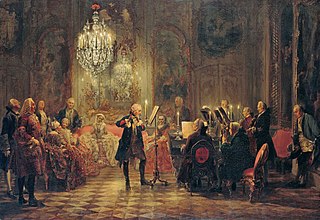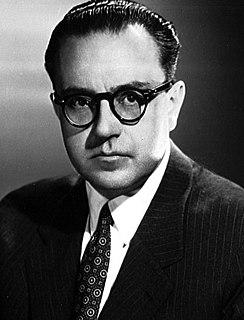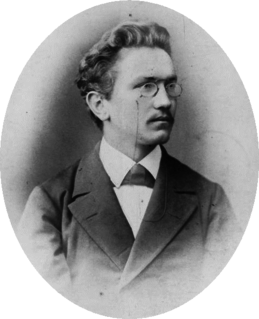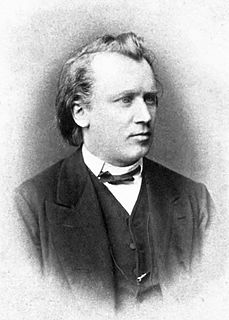
Chamber music is a form of classical music that is composed for a small group of instruments—traditionally a group that could fit in a palace chamber or a large room. Most broadly, it includes any art music that is performed by a small number of performers, with one performer to a part. However, by convention, it usually does not include solo instrument performances.
In music, perpetuum mobile, moto perpetuo (Italian), mouvement perpétuel (French), movimento perpétuo (Portuguese) movimiento perpetuo (Spanish), carries two distinct meanings: first, as describing entire musical compositions or passages within them that are characterised by a continuous stream of notes, usually at a rapid tempo; and also as describing entire compositions, or extended passages within them that are meant to be played in a repetitious fashion, often an indefinite number of times.

Anton Stepanovich Arensky was a Russian composer of Romantic classical music, a pianist and a professor of music.

The Piano Quintet in E-flat major, Op. 44, by Robert Schumann was composed in 1842 and received its first public performance the following year. Noted for its "extroverted, exuberant" character, Schumann's piano quintet is considered one of his finest compositions and a major work of nineteenth-century chamber music. Composed for piano and string quartet, the work revolutionized the instrumentation and musical character of the piano quintet and established it as a quintessentially Romantic genre.
The Piano Quintet in F minor, Op. 34, by Johannes Brahms was completed during the summer of 1864 and published in 1865. It was dedicated to Her Royal Highness Princess Anna of Hesse. Like most piano quintets composed after Robert Schumann's Piano Quintet (1842), it is written for piano and string quartet.

Alberto Evaristo Ginastera was an Argentinian composer of classical music. He is considered one of the most important 20th-century classical composers of the Americas.

The Piano Sonata No. 32 in C minor, Op. 111, is the last of Ludwig van Beethoven's piano sonatas. Along with Beethoven's 33 Variations on a waltz by Anton Diabelli, Op. 120 (1823) and his two collections of bagatelles—Op. 119 (1822) and Op. 126 (1823)—this was one of Beethoven's last compositions for piano. The work was written between 1821 and 1822. Like other "late period" sonatas, it contains fugal elements. It was dedicated to his friend, pupil, and patron, Archduke Rudolf.

Hans Huber was a composer from Switzerland who, between 1894 and 1918, composed five operas. His piano concertos are slightly unusual for the form in that they have, like Brahms' second piano concerto in B-flat major, four movements. He also wrote a set of 24 Preludes and Fugues, Op. 100, for piano four-hands in all the keys.
The Simple Symphony, Op. 4, is a work for string orchestra or string quartet by Benjamin Britten. It was written between December 1933 and February 1934 in Lowestoft, using bits of score that the composer had written for the piano as a young teenager, between 1923 and 1926. It was composed for string orchestra and received its first performance in 1934 at Stuart Hall in Norwich, with Britten conducting an amateur orchestra.

B-flat minor is a minor scale based on B♭, consisting of the pitches B♭, C, D♭, E♭, F, G♭, and A♭. Its key signature has five flats. Its relative major is D-flat major and its parallel major is B-flat major. Its enharmonic equivalent, A-sharp minor, which would contain seven sharps, is not normally used.

Woldemar Bargiel was a German composer.

Dora Pejačević was a Croatian composer, a member of the Pejačević noble family. She was one of the composers to introduce the orchestral song to Croatian music and her Symphony in F-sharp minor is considered by scholars to be the first modern symphony in Croatian music.
Beethoven's Piano Sonata No. 2 in A major, Op. 2, No. 2, was published in 1796 and dedicated to Joseph Haydn. A typical performance lasts 22 minutes. Tovey wrote, "The second sonata is flawless in execution and entirely beyond the range of Haydn and Mozart in harmonic and dramatic thought, except in the Finale." The sonata was the first Beethoven sonata to reach America and was performed in New York on June 5 1807.

The Piano Quartet No. 3 in C minor, Op. 60, completed by Johannes Brahms in 1875, is scored for piano, violin, viola and cello. It is sometimes called the Werther Quartet after Goethe's The Sorrows of Young Werther.
Johannes Brahms' String Quintet No. 1 in F major, op. 88, was composed in 1882 in the spa town of Bad Ischl, Upper Austria, and published by the firm of Fritz Simrock. It was first performed at a chamber music evening in Frankfurt-on-Main on 29 December 1882.
The String Quartet No. 2 in F major, Op. 22, by Pyotr Ilyich Tchaikovsky, was composed between December 1873 and January 1874.

The Piano Quartet No. 2 in A major, Op. 26, by Johannes Brahms is scored for piano, violin, viola and cello. It was completed in 1861 and received its premiere in November 1863 by the Hellmesberger Quartet with the composer playing the piano part. It has been especially noted for drawing influence from composer Franz Schubert. Lasting approximately 50 minutes, this quartet is the longest of Brahms's chamber works to perform. He also made an arrangement of this quartet for two pianos.
The Piano Quartet No. 2 in G major, Op. 26 by Henrique Oswald was composed in the second half of 1898. It is scored for piano, violin, viola and cello. The approximate duration is 25–30 minutes.










